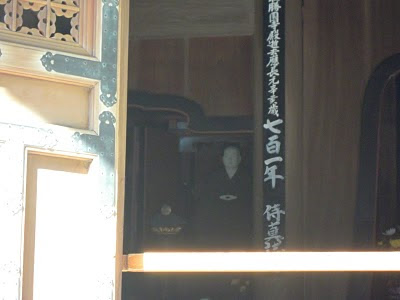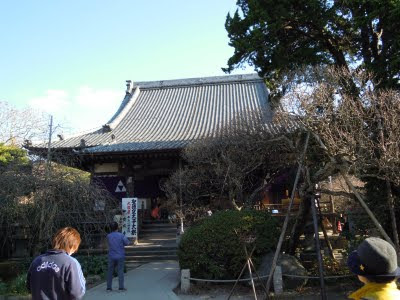One day in January I was requested by a Britsh filmmaker to show them around Kamakura. They had a plan make a documentary about 14th century Kamakura, especially a battle in 1333. I prepared for it, but it ended in vain. They changed their schedule and my preparation didn't bear fruit.I wasn't disappointed at it, but rather I appreciate their request. Because I could deepen my knowledge about Kamakura. This is a statue of Yoshisada Nitta which is in the west city of Tokyo, Fuchu. Exactly speaking it stands in front of Bubaigawara station of the Keio line.He was the man who finished the Kamakura government.
This is a statue of Yoshisada Nitta which is in the west city of Tokyo, Fuchu. Exactly speaking it stands in front of Bubaigawara station of the Keio line.He was the man who finished the Kamakura government. At the behest of the then Emperor Godaigo who wanted to recover sovereign power from the regent of the Kamakura government(=Hojo family), he raised an army in the current Gunma area. At first Yoshisada Nitta's army was small but gradually increased the number. Takauji Ashikaga whom I introduced in my previous column of this blog played an important role of this battle. He lived in Kamakura. His clan had relation with Hojo clan by marriage. Takauji's wife was a sister of the then regent-Moritoki Hojo. So, Takauji was sent to Kyoto to quell the Emprpor Godaigo's group. But Takauji went over to the other side. He helped Yoshisada Nitta, who won the battle at Bubaigawara. The above picure is a monument of that battle in Fuchu. Meanwhile, Takauji took over the Kamakura government's main Kyoto fortress called Rokuhara. Soon after the battle in Fuchu Yoshisada Nitta directed to Kamakura. However, it was difficult for Yoshisada's army to invade Kamakura because it was surrounded by the mountains and the sea. Yoshisada decided to invade Kamakura through the seashore. The picture below is Inamura-gasaki promonto.
At the behest of the then Emperor Godaigo who wanted to recover sovereign power from the regent of the Kamakura government(=Hojo family), he raised an army in the current Gunma area. At first Yoshisada Nitta's army was small but gradually increased the number. Takauji Ashikaga whom I introduced in my previous column of this blog played an important role of this battle. He lived in Kamakura. His clan had relation with Hojo clan by marriage. Takauji's wife was a sister of the then regent-Moritoki Hojo. So, Takauji was sent to Kyoto to quell the Emprpor Godaigo's group. But Takauji went over to the other side. He helped Yoshisada Nitta, who won the battle at Bubaigawara. The above picure is a monument of that battle in Fuchu. Meanwhile, Takauji took over the Kamakura government's main Kyoto fortress called Rokuhara. Soon after the battle in Fuchu Yoshisada Nitta directed to Kamakura. However, it was difficult for Yoshisada's army to invade Kamakura because it was surrounded by the mountains and the sea. Yoshisada decided to invade Kamakura through the seashore. The picture below is Inamura-gasaki promonto. When I was a kid, I learned a legendary story with a rhythm. Great commander Yoshisada Nitta put his sword in the sea of the Shichiriga-hama beach, and then the tide receded.That reflux led him to a victory.
When I was a kid, I learned a legendary story with a rhythm. Great commander Yoshisada Nitta put his sword in the sea of the Shichiriga-hama beach, and then the tide receded.That reflux led him to a victory.  These two pictures are the memorial park of Sadayoshi Nitta at the Inamuragasaki Promonto(above) and the monument(below).
These two pictures are the memorial park of Sadayoshi Nitta at the Inamuragasaki Promonto(above) and the monument(below).
 Gokuraku-ji Kiritoshi(cutting)
Gokuraku-ji Kiritoshi(cutting)
 Kehaizaka kiritoshi(cutting)
Kehaizaka kiritoshi(cutting)  This monument stands at Suzaki in the east Kamakura area, the site of the final battle where the Hojo clan led by Moritoki Hojo was defeated.
This monument stands at Suzaki in the east Kamakura area, the site of the final battle where the Hojo clan led by Moritoki Hojo was defeated.  Moritiki Hojo committed suicide by means of harakiri. The above is said to be the site of 'harakiri'
Moritiki Hojo committed suicide by means of harakiri. The above is said to be the site of 'harakiri' In the precinct of Togaku-ji Temple there are remains of the Hojo clan. This temple is close to Shonan-Fukazawa station of the monorail line.
In the precinct of Togaku-ji Temple there are remains of the Hojo clan. This temple is close to Shonan-Fukazawa station of the monorail line. Yoshisada Nitta founded a temple named Kuhon-ji Temple in the Zaimokuza area which is in the southern part of Kamakura to mourn the Hojo clan.
Yoshisada Nitta founded a temple named Kuhon-ji Temple in the Zaimokuza area which is in the southern part of Kamakura to mourn the Hojo clan.  This is a statue of the last(9th) heir apparent and the 14th regent, Takatoki Hojo, enshrined in Engaku-ji Temple with his father Sadatoki, the 9th regent, and grandfather Tokimune, the 8th regent.
This is a statue of the last(9th) heir apparent and the 14th regent, Takatoki Hojo, enshrined in Engaku-ji Temple with his father Sadatoki, the 9th regent, and grandfather Tokimune, the 8th regent.  This is the site where Tosho-ji Temple used to be situated and Takatoki Hojo's family and his vassals finished their lives burning the temple.
This is the site where Tosho-ji Temple used to be situated and Takatoki Hojo's family and his vassals finished their lives burning the temple. This the cave which was at the back of Tosho-ji Temple. Takatoki committed suicide by means of 'harakiri'.
This the cave which was at the back of Tosho-ji Temple. Takatoki committed suicide by means of 'harakiri'. Hokai-ji Temple was build to mourn the Hojo clan by Takauji Ashikaga by the order of Emperor Godaigo. The temle is situated in an area where Hojo clan used to live.
Hokai-ji Temple was build to mourn the Hojo clan by Takauji Ashikaga by the order of Emperor Godaigo. The temle is situated in an area where Hojo clan used to live.
 This is a statue of Yoshisada Nitta which is in the west city of Tokyo, Fuchu. Exactly speaking it stands in front of Bubaigawara station of the Keio line.He was the man who finished the Kamakura government.
This is a statue of Yoshisada Nitta which is in the west city of Tokyo, Fuchu. Exactly speaking it stands in front of Bubaigawara station of the Keio line.He was the man who finished the Kamakura government. At the behest of the then Emperor Godaigo who wanted to recover sovereign power from the regent of the Kamakura government(=Hojo family), he raised an army in the current Gunma area. At first Yoshisada Nitta's army was small but gradually increased the number. Takauji Ashikaga whom I introduced in my previous column of this blog played an important role of this battle. He lived in Kamakura. His clan had relation with Hojo clan by marriage. Takauji's wife was a sister of the then regent-Moritoki Hojo. So, Takauji was sent to Kyoto to quell the Emprpor Godaigo's group. But Takauji went over to the other side. He helped Yoshisada Nitta, who won the battle at Bubaigawara. The above picure is a monument of that battle in Fuchu. Meanwhile, Takauji took over the Kamakura government's main Kyoto fortress called Rokuhara. Soon after the battle in Fuchu Yoshisada Nitta directed to Kamakura. However, it was difficult for Yoshisada's army to invade Kamakura because it was surrounded by the mountains and the sea. Yoshisada decided to invade Kamakura through the seashore. The picture below is Inamura-gasaki promonto.
At the behest of the then Emperor Godaigo who wanted to recover sovereign power from the regent of the Kamakura government(=Hojo family), he raised an army in the current Gunma area. At first Yoshisada Nitta's army was small but gradually increased the number. Takauji Ashikaga whom I introduced in my previous column of this blog played an important role of this battle. He lived in Kamakura. His clan had relation with Hojo clan by marriage. Takauji's wife was a sister of the then regent-Moritoki Hojo. So, Takauji was sent to Kyoto to quell the Emprpor Godaigo's group. But Takauji went over to the other side. He helped Yoshisada Nitta, who won the battle at Bubaigawara. The above picure is a monument of that battle in Fuchu. Meanwhile, Takauji took over the Kamakura government's main Kyoto fortress called Rokuhara. Soon after the battle in Fuchu Yoshisada Nitta directed to Kamakura. However, it was difficult for Yoshisada's army to invade Kamakura because it was surrounded by the mountains and the sea. Yoshisada decided to invade Kamakura through the seashore. The picture below is Inamura-gasaki promonto. When I was a kid, I learned a legendary story with a rhythm. Great commander Yoshisada Nitta put his sword in the sea of the Shichiriga-hama beach, and then the tide receded.That reflux led him to a victory.
When I was a kid, I learned a legendary story with a rhythm. Great commander Yoshisada Nitta put his sword in the sea of the Shichiriga-hama beach, and then the tide receded.That reflux led him to a victory.  These two pictures are the memorial park of Sadayoshi Nitta at the Inamuragasaki Promonto(above) and the monument(below).
These two pictures are the memorial park of Sadayoshi Nitta at the Inamuragasaki Promonto(above) and the monument(below).
 Gokuraku-ji Kiritoshi(cutting)
Gokuraku-ji Kiritoshi(cutting)
 Kehaizaka kiritoshi(cutting)
Kehaizaka kiritoshi(cutting)  This monument stands at Suzaki in the east Kamakura area, the site of the final battle where the Hojo clan led by Moritoki Hojo was defeated.
This monument stands at Suzaki in the east Kamakura area, the site of the final battle where the Hojo clan led by Moritoki Hojo was defeated.  Moritiki Hojo committed suicide by means of harakiri. The above is said to be the site of 'harakiri'
Moritiki Hojo committed suicide by means of harakiri. The above is said to be the site of 'harakiri' In the precinct of Togaku-ji Temple there are remains of the Hojo clan. This temple is close to Shonan-Fukazawa station of the monorail line.
In the precinct of Togaku-ji Temple there are remains of the Hojo clan. This temple is close to Shonan-Fukazawa station of the monorail line. Yoshisada Nitta founded a temple named Kuhon-ji Temple in the Zaimokuza area which is in the southern part of Kamakura to mourn the Hojo clan.
Yoshisada Nitta founded a temple named Kuhon-ji Temple in the Zaimokuza area which is in the southern part of Kamakura to mourn the Hojo clan.  This is a statue of the last(9th) heir apparent and the 14th regent, Takatoki Hojo, enshrined in Engaku-ji Temple with his father Sadatoki, the 9th regent, and grandfather Tokimune, the 8th regent.
This is a statue of the last(9th) heir apparent and the 14th regent, Takatoki Hojo, enshrined in Engaku-ji Temple with his father Sadatoki, the 9th regent, and grandfather Tokimune, the 8th regent.  This is the site where Tosho-ji Temple used to be situated and Takatoki Hojo's family and his vassals finished their lives burning the temple.
This is the site where Tosho-ji Temple used to be situated and Takatoki Hojo's family and his vassals finished their lives burning the temple. This the cave which was at the back of Tosho-ji Temple. Takatoki committed suicide by means of 'harakiri'.
This the cave which was at the back of Tosho-ji Temple. Takatoki committed suicide by means of 'harakiri'. Hokai-ji Temple was build to mourn the Hojo clan by Takauji Ashikaga by the order of Emperor Godaigo. The temle is situated in an area where Hojo clan used to live.
Hokai-ji Temple was build to mourn the Hojo clan by Takauji Ashikaga by the order of Emperor Godaigo. The temle is situated in an area where Hojo clan used to live.
No comments:
Post a Comment